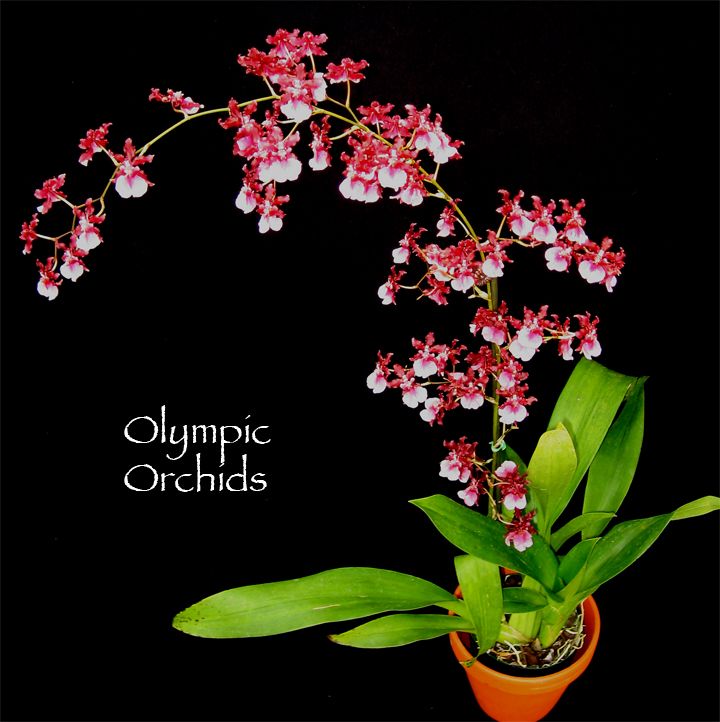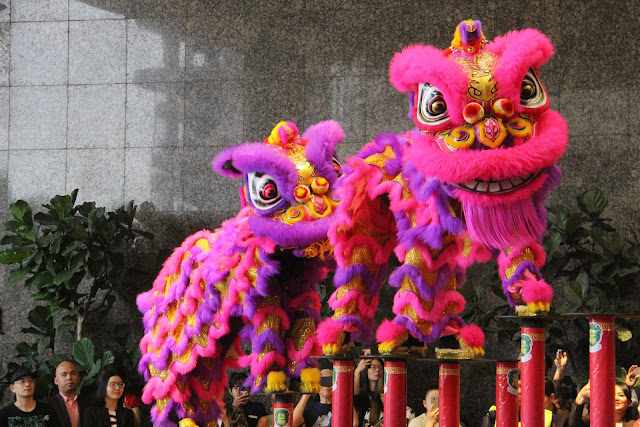How to take care of dancing lady orchid
Growing Orchids: Oncidium, or Dancing Lady
Fill your home with dancing sprays of delicate blossoms when you start growing orchids in the Oncidium family.
If you’ve mastered the skill of growing orchids like phaelanopsis and dendrobiums, you might be ready to step up to more challenging varieties like ondidium orchids, fancifully known as “Dancing Ladies.” These orchids are a bit pickier about light, temperature, and watering requirements, so do your research carefully before giving them a try. Here are some basics to get you started.
About Oncidium
Oncidium (say “on-SID-ee-um”) orchids are New World orchids, found in South and Central America and the West Indies, with one species in South Florida. There are over 300 species of oncidiums, but the most popular for home growers are the yellow or pink-flowered varieties sold simply as “Dancing Lady.” These are generally large plants, with long and abundant leaves. They flower in late summer or early fall, with dozens of blooms on multiple stems that can last for months. After they finish blooming, they enter a growth cycle, where they put on new leaves. They’re dormant in the early summer as they prepare to bloom again.
Temperature
Dancing Lady orchids like warm temperatures and moderate humidity. They prefer a minimum of 80 degrees F during the day, with at least 40% humidity. At night, they can tolerate temperatures down to about 55 degrees F. In some areas, you may find it hard to maintain the required temperatures and humidity during the winter months without a greenhouse. However, if you can keep oncidiums in a warm room and provide extra humidity (setting the pot on a shallow tray filled with pebbles and water helps), growing orchids in this family may be a possibility.
Light
Oncidiums tolerate more direct light than some other orchids. They do well in east or west windows, though it doesn’t hurt to soften the light a bit with a sheer curtain. Healthy Dancing Lady orchids have medium green leaves; dark green leaves indicate they aren’t getting enough sun.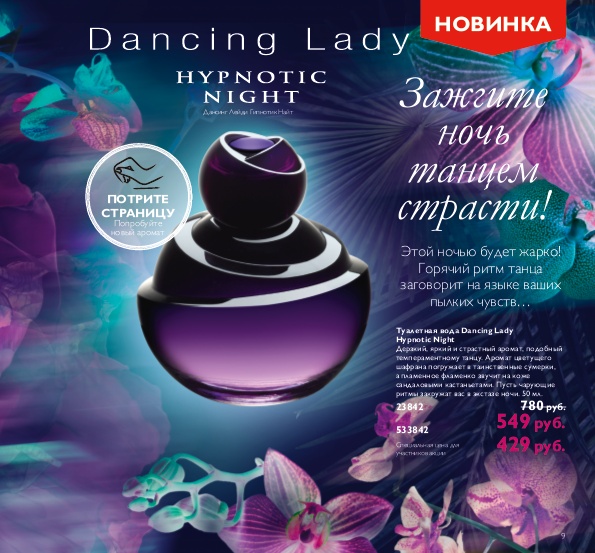
Jill Staake
Water
Watering oncidiums properly can get tricky. They are very susceptible to root rot, so like other orchids they should never be left sitting in water. In fact, it’s best to let the potting mix dry out about halfway down the pot before watering. Stick your finger or a wood popsicle stick down into the mix. If it still feels wet, wait a few days more. The time between waterings will vary depending on the time of year and the plant’s growth cycle.
Potting and Fertilizing
Orchids need quick-draining potting material. Specially-designed orchid mixes made of bark, sphagnum moss, and other loose fillers are ideal. Do not use traditional potting soil or soil from your garden. Ensure the pot has holes for good drainage. Feed with a weak fertilizer once or twice a month. It’s better to underfeed than overfeed when growing orchids.
Maintenance
When the flowers begin to fade, allow them to drop naturally. Don’t remove the flower spike until it has turned completely brown and dry. Oncidiums prefer to be somewhat pot-bound, but may need re-potting every couple of years. This requires a cautious hand so as not to break the roots. Do a web search before re-potting to find a site that can walk you through the process.
Don’t remove the flower spike until it has turned completely brown and dry. Oncidiums prefer to be somewhat pot-bound, but may need re-potting every couple of years. This requires a cautious hand so as not to break the roots. Do a web search before re-potting to find a site that can walk you through the process.
Interested in more on growing orchids? See our guide to Orchids 101 here.
Popular Videos
Jill Staake
Jill lives in Tampa, Florida, and writes about gardening, butterflies, outdoor projects and birding. When she's not gardening, you'll find her reading, traveling and happily digging her toes into the sand on the beach.
Oncidium (Dancing Lady Orchid): In-Depth Care Guide
Oncidium orchids, also commonly known as “Dancing Lady” orchids, are known for their vibrant colors and uniquely shaped flowers. This makes them very popular with orchid enthusiasts.
However, they are more particular about care than many other types of orchid. They require lots of light, and you should take extra care when choosing a potting mix or repotting an Oncidium, due to their relatively fine roots.
They require lots of light, and you should take extra care when choosing a potting mix or repotting an Oncidium, due to their relatively fine roots.
In this care guide, we’re going to take a closer look at these wonderful plants and their care requirements.
Natural Habitat
An important first step in learning to care for any type of orchid is to understand the conditions in which it grows naturally.
Oncidiums grow in the wild, primarily in jungles of Central and South America, and the West Indies. You can find them growing high in the Andes, and in the Amazon rainforest.
The conditions you provide should mimic this environment. Think warm, humid, with plenty of indirect light through the tree cover, and you’re well on your way to knowing how to care for one.
Dancing Lady orchids are usually epiphytes, depending on the variety. This means that in the wild, they grow on trees by clinging to the bark. They can also sometimes grow on rocks.
They can also sometimes grow on rocks.
Bear this in mind when choosing a potting mix. As we’ll see later, a combination of bark and moss tends to work well.
How to Care for an Oncidium Orchid
With their natural habitat in mind, let’s break down each care aspect in a bit more detail.
Light
Oncidiums require plenty of light, and although these orchids are more tolerant than other species, the light should be indirect. Remember, the light filters through the treetops in the wild, rather than striking the plant directly.
When grown indoors, these plants can be placed in an east-, west-, or south-facing window. This will often ensure similar lighting conditions. A good guideline is 2000 to 4000 footcandles of light.
If you want to check whether you’ve got this right, the most reliable way is to buy a light meter.
You can also use the “hand test” – on a bright, clear day, hold your hand about 12 inches away from the leaves of your plant. If the shadow cast by your hand is clear and dark, you’ll know you have enough light to support an Oncidium.
If the shadow cast by your hand is clear and dark, you’ll know you have enough light to support an Oncidium.
Too much direct light can cause sunburn. If you’re worried about this, you can buy a thin cloth screen to put over your window. This will diffuse the light, while still letting most of it through.
Related: How Much Light Do Orchids Need?
Temperature
Dancing Lady orchids prefer warm temperatures. The average temperature in the Amazon, for instance, is about 77 degrees Fahrenheit.
So, you should aim to keep the temperature around 75-80 degrees Fahrenheit during the day. You can use a standard household thermometer to measure this.
The temperature should not drop below 55 degrees Fahrenheit at night. It’s fine for the temperature to drop a bit, however, as that will help the plants bloom.
Humidity
Like most orchid species, Oncidium orchids prefer medium to high humidity. As epiphytic orchids, they absorb a lot of the moisture they need from humidity in the air, through their roots.
These plants should live in an area with at least 40 percent humidity, although humidity levels between 50 and 60 percent are ideal. Again, you can get a meter to measure this. These are often combined with a thermometer, which is handy.
If you need to, you can increase humidity using a humidifier or humidity tray. However, it’s important to maintain good airflow around the plants to prevent bacteria and rot.
Alternatively, you can keep your plant in one of the more humid rooms in your house, such as a kitchen or bathroom. Just make sure to check the actual humidity, temperature, and light levels there, as this varies from home to home.
Watering
Oncidium altissimumBecause they generally grow with their roots exposed to the air, Dancing Lady orchids require specific watering routines so as not to rot the roots. The roots should be allowed to nearly dry out between each watering session.
Plants with thin leaves will require slightly more water than those with water-retaining leaves.
To judge whether your plant needs more water, you can look at the pseudobulbs. These are a thickened part of the stem used for water storage. Oncidiums have large pseudobulbs at the base of the plant. Wrinkled pseudobulbs are a sign that the orchid needs more water.
To water your orchid, immerse the pot in water until the potting medium is soaked through. Then, drain it thoroughly and make sure there is no standing water left. This should take about 10 to 15 minutes. This watering pattern mimics the bouts of heavy rainfall in your orchid’s rainforest habitat.
Oncidiums don’t like too many minerals in their water, so distilled water is a good option. Make sure the water isn’t too cold or hot, as this can damage the roots.
Related: How to Water an Orchid: Care Guide
Potting Mix & Pot
The potting medium used for Oncidiums should be fairly loose and should drain easily. Because they have relatively fine roots, don’t use a very coarse mix as you would for a Phalaenopsis – go for a medium-grade mix instead.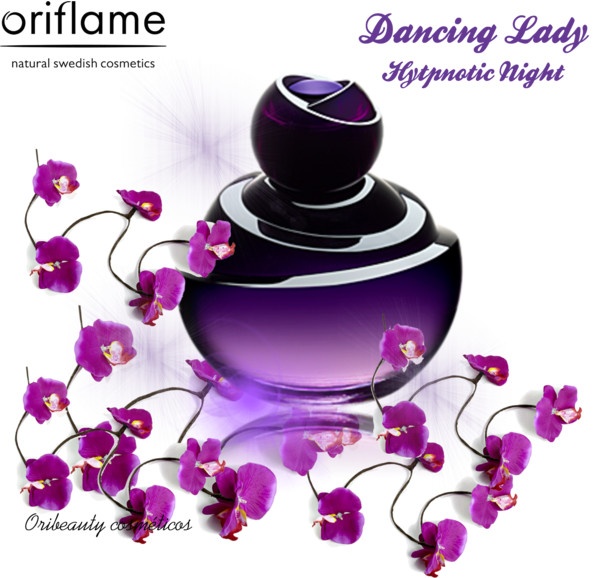
A mix of bark and sphagnum moss in equal quantities works best. Osmunda fern fiber is another great option if you’re able to find it.
Pots should have several holes in them to promote drainage and airflow. You can find a variety of pots specifically for orchids, such as net pots and clear plastic pots, at your local garden store.
For Oncidiums, it’s best to pick a pot that’s slightly on the smaller side, as they prefer a snug fit.
Related: Orchid Potting Mix: Care Guide & Information
Related: Best Orchid Pots: Beginner’s Buying Guide
Repotting
Because Oncidium orchids prefer to be in tighter pots, repotting should be done infrequently. How often it needs to be done depends on the plant, but generally, they should only be repotted once every two years.
Repotting should be done after the growth season. Wait until the plant has finished blooming, to avoid damaging it.
These plants have extremely fragile roots, so take care when repotting an Oncidium orchid.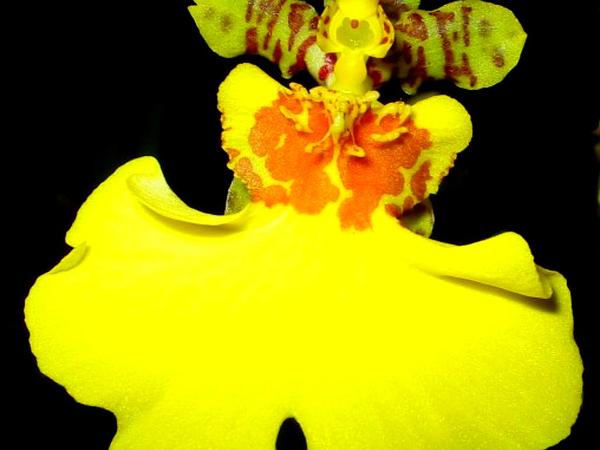 Check out our repotting guide to learn how to do this safely.
Check out our repotting guide to learn how to do this safely.
Related: How to Repot an Orchid: Step by Step Guide
Blooms
Different species of Oncidium orchid bloom at different times throughout the year. Some species will even flower multiple times within the year.
Once the plant blooms, the flowers can last for a few weeks or even a few months. It is important not to trim the stems of the plant once the flowers have gone, as flowers often bloom on the same stems over and over.
If a plant isn’t blooming, it can be exposed to slightly colder nighttime temperatures. This may induce the plant to flower. Make sure the temperature stays above 55 degrees Fahrenheit.
Related: How Often Do Orchids Bloom? (And How Can I Make It Happen?)
Fertilizer
In addition, you can give your plant some fertilizer every 2 to 3 weeks, which will help provide it with the nutrients it needs. Use a 30-10-10 orchid fertilizer and dilute it to quarter to half strength.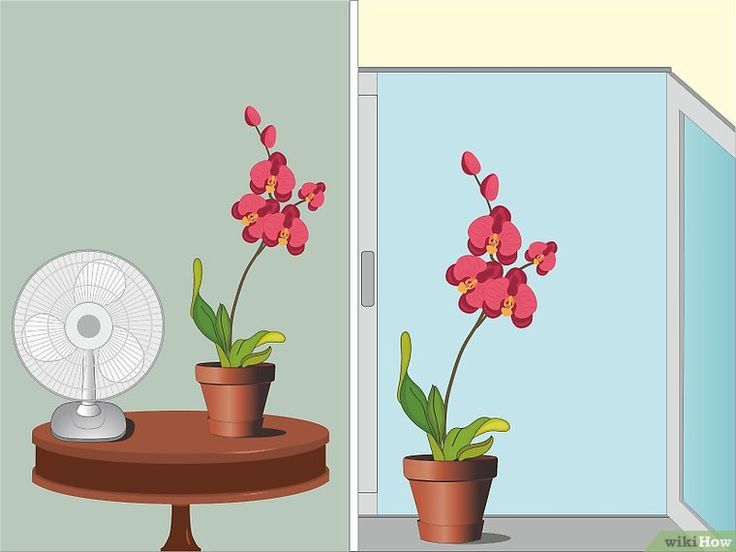
Remember that it’s best to err on the side of underfeeding your orchid, as too much can burn the delicate roots.
Check out our fertilizer guide for more detail on how to choose the right type of fertilizer and apply it correctly:
Related: Orchid Fertilizer: Everything You Need to Know
Pruning
After the blooming season has finished, you can remove the old flowering spikes from your Oncidium. This will prevent the plant from wasting any further resources on them.
Sterilize your tools with boiling water and alcohol, to avoid the risk of bacterial or fungal infections. Using a sharp blade, carefully cut the spike close to the pseudobulb. Try to leave less than an inch of the spike.
If you’ve accidentally over-watered your orchid, you may find its pseudobulbs starting to go mushy and rotten. To stop the rot spreading, you may need to remove the rotten pseudobulb. Again, use a sharp sterile blade to do this and be careful not to remove too much healthy tissue.
Related: How to Prune an Orchid: Step by Step Guide
Propagation
The easiest way to propagate a Dancing Lady orchid is by division, once it grows large enough.
To do this, carefully remove your orchid from its pot. You may need to cut the pot away to avoid damaging the plant.
Then, start dividing your orchid into pieces with at least 3 to 4 pseudobulbs per piece. Be very careful not to damage the fragile roots. You can use a sterile blade to help, but only when necessary.
Repot these pieces in fresh potting mix and care for them just as you would with a new plant.
It’s also possible to use backbulbs to propagate an Oncidium. Other methods such as cuttings and Keikis are uncommon.
Related: How to Propagate Orchids: Complete Care Guide
Oncidium Care Summary & Cheat Sheet
Let’s recap what we just learned:
| Light | 2000 to 4000 footcandles, indirect |
| Temperature | 80 degrees Fahrenheit during the day No lower than 55 degrees during the night |
| Humidity | 50 to 60 percent |
| Watering | Sparingly, when pseudobulbs start to wrinkle |
| Potting Mix | Medium-grade mix of 1:1 bark and sphagnum moss |
| Pot | Smaller pot with good drainage |
| Repotting | Every 2 years, after blooming |
| Blooms | Expose to cooler temperatures to encourage blooming |
| Fertilizer | Weak 30-10-10 fertilizer, every 2 to 3 weeks |
| Pruning | Remove old spikes and rotten pseudobulbs, when necessary |
| Propagation | Using division or backbulbs |
If you’d like to download this as a handy cheat sheet, right-click the image below and select “Save Image”:
We recommend printing it off and keeping it by your orchid.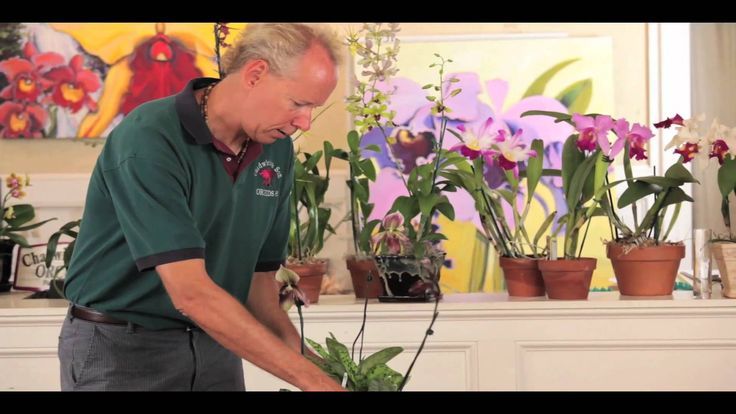 Please share it if you find it useful!
Please share it if you find it useful!
Care Video
If you’d like to see all this in action, check out this great YouTube video from MissOrchidGirl:
Frequently Asked Questions
Here are some common questions about Oncidiums:
Which Species Are Easiest to Grow?
Oncidium flexuosumSome species of Oncidium are easier to grow than others.
We really like the Sharry Baby, which is sometimes called the “chocolate orchid” due to its scent. This species is widely available and is great for beginners.
We also recommend Oncidium flexuosum, which requires less watering and fertilizer than most other species.
How Can I Make My Oncidium Bloom Again?
It takes a lot of resources for your plant to grow flowers, so it’s usually seasonal and you shouldn’t expect it to be in bloom all the time.
If your orchid hasn’t bloomed for a while, first you should check when this normally happens. This will vary depending on the exact species, even with the same genus. Look up your particular plant online and find out when to expect this.
You can try to induce blooming by lowering the temperature at night, and by applying fertilizer. Just make sure you don’t overdo this, and remember that the best way to get your orchid to flower is to give it the best all-round care.
Why Are My Plant’s Leaves Turning Yellow?
If your Dancing Lady orchid is starting to develop yellow leaves, there are a few possible causes.
You might be over-watering it and causing root rot. Check the roots to see whether this is the case, and make sure your pot and medium have sufficient drainage.
It’s also possible your orchid has sunburn due to too much direct sunlight. Make sure the light is indirect.
If you’re still not sure, check out our article about this common issue for more detail.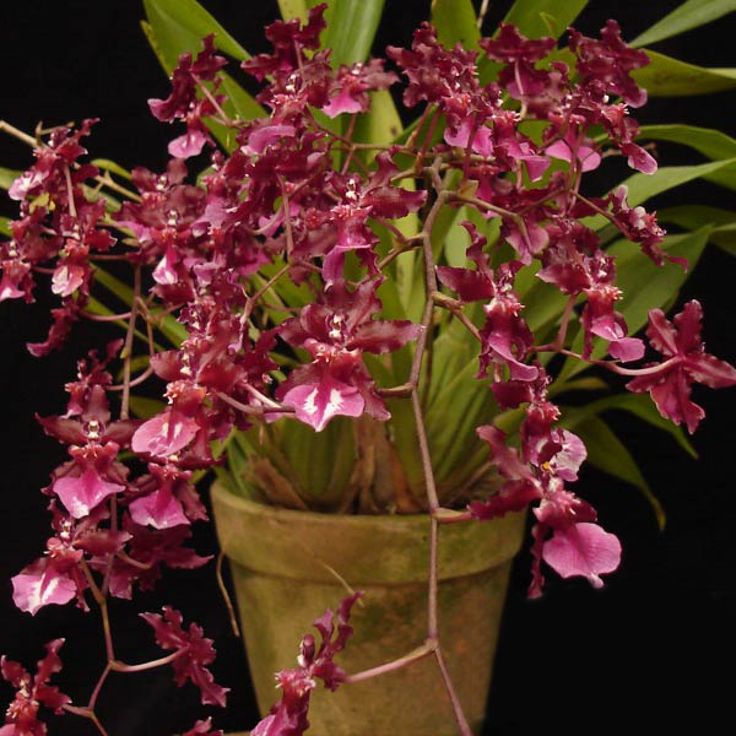
Do you have any secrets or tips for growing Oncidiums? Leave a comment below and let us know!
Pin It!
If you enjoyed this article, please share it using the buttons below. It really helps us out!
Oncidium - care features, why do the stems and leaves of the plant rot?
Latin name : Oncidium
Category: Perennial grassy plants
Rodina: Subtropics and Tropics of South and Central America
ONCIDIUM ONCIDIUM - Exotic Queen of Tropics
ONCIDIUM (ONCIDIUM) , herbaceous perennials of this genus are directly related to the orchid family, which includes more than seven hundred species of plants that are completely different from each other. Most of the oncidiums are epiphytic individuals that have chosen the trunks or branches of large plants, the smaller ones are lithophytes that prefer rocks, as well as terrestrial representatives.
And these beautiful exotics spread from high-altitude territories, about three thousand meters above sea level, South and Central America, Mexico and India. Tropical rainforests, sky-high mountain peaks and savannahs with sharp seasonal and daily temperature changes are acceptable for oncidiums.
Tropical rainforests, sky-high mountain peaks and savannahs with sharp seasonal and daily temperature changes are acceptable for oncidiums.
Description of this beautiful genus back in 1800 was made by the Swede, botanist Peter Olof Swartz.
Oncidium "dancing dolls" or "dancing lady" - such folk names have a plant for the identity of its flowers with a girl in a voluminous, fluffy skirt.
Oncidium orchids quickly spread and became very popular with our flower lovers. This regal plant will be the center of attention among pets and decorate the home greenhouse with its presence.
There is a huge species diversity of oncidiums, but still they have common features and coincidences. They belong to sympodial orchids and can be compared with a creeping vine. And this horizontally growing miracle consists of rhizomes - modified stems with nodes and internodes, from where leaves and pseudobulbs grow - with many aerial root shoots. The leaves of the plant are oblong and narrow. From the axils of the leaves in the cool season, a tall, very branched peduncle appears. A paniculate inflorescence with a huge number of zygomorphic flowers rises on it. The uniqueness and originality of a flower comes from its structure.
From the axils of the leaves in the cool season, a tall, very branched peduncle appears. A paniculate inflorescence with a huge number of zygomorphic flowers rises on it. The uniqueness and originality of a flower comes from its structure.
The perianth is the center of symmetry.
Sepals consist of three small sepals of the same size, and petals are two beautiful flower petals and the third is a large three-lobed lip - labellum, with a noticeable, complex shape, outgrowth.
Thanks to this outgrowth, the Latin name of oncidium comes from a combination of the words of the Greek alphabet: "onkos" - tubercles, swellings, tumors; "eidos" - samples, types.
Species and hybrid varieties of oncidium
Papilio Oncidium
The most spectacular epiphytic butterfly orchid native to the mountainous, forested areas of South America.
A unique exotic with rounded bright green pseudobulbs and leathery, greenish-olive leaves with marbled, reddish stains, sometimes in the singular. The base of the pseudobulb is the site of the appearance of a huge peduncle from 60 cm to one and a half meters high, which does not disappear for more than two years, periodically unusual bizarre brown-red flowers appear on it one by one in the autumn. They resemble a butterfly with long antennae.
The base of the pseudobulb is the site of the appearance of a huge peduncle from 60 cm to one and a half meters high, which does not disappear for more than two years, periodically unusual bizarre brown-red flowers appear on it one by one in the autumn. They resemble a butterfly with long antennae.
Tiger oncidium (Oncidium tigrinum)
Tiger orchid is an epiphytic flower in which two or three plump, woody, leathery leaflets of purple tinted color flaunt with age juicy brown-violet. On a slightly branched, long, up to 80 cm tall, peduncle, up to twenty bright yellow flowers with brown speckles gradually bloom with a very large, kidney-shaped lemon-yellow lip. And you can contemplate this beauty in winter, starting in December.
Oncidium yellow
The profusely flowering and fast growing variety of yellow oncidiums is very popular and suitable for indoor cultivation. A huge number of three centimeter yellow flowers with a lemon tint and a reddish speck at the base of the lip bloom at the same time and adorn the branched peduncle. The festive atmosphere created by the dancing doll lasts for more than a month.
A huge number of three centimeter yellow flowers with a lemon tint and a reddish speck at the base of the lip bloom at the same time and adorn the branched peduncle. The festive atmosphere created by the dancing doll lasts for more than a month.
Oncidium Sveet sugar (Oncidium Sveet sugar)
A very common unpretentious, compact hybrid of bright yellow orchids - oncidiums. And they fell in love with him for accelerated growth and generous flowering. This miracle will decorate any interior, cheer you up and create a positive atmosphere. Even cut bouquets will be beautiful for two weeks.
Oncidium Twinkle
Miniature hybrid variety of oncidium, resistant to temperature extremes. Small pink, white, light yellow, red flowers of the Twinkle orchid, 1.5 cm in size, emit the aroma of fresh cinnamon buns.
Oncidium lanceanum (Oncidium lanceanum)
The most ornamental type of oncidium orchid from the humid forests of the northeastern part of the South American continent.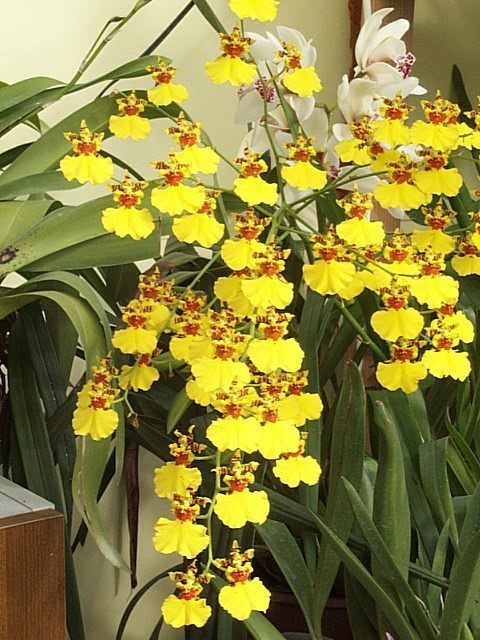 Here, in natural conditions, this plant was found in 1834 by John Henry Lance and named after him.
Here, in natural conditions, this plant was found in 1834 by John Henry Lance and named after him.
Tall epiphytic orchid with bright green, oval, stiff leaves mottled brown-red or purple. About twenty fragrant greenish-yellow flowers are located on a massive, slightly branched peduncle.
Oncidium home care
Like all houseplants in pots , oncidiums desire natural growing conditions. To do this, first of all, it is necessary to properly water the oncidium orchid, provide pleasant warmth, proper lighting and create a rest period correctly, according to the rules. This can be achieved if you gradually reduce watering and reduce the ambient temperature by 4-5 ° C. And after three months, perform the reverse process and soon we will get a generously blooming and eye-pleasing orchid.
Choosing a place
Light-loving oncidiums will not be against the bright sun, but at peak it is better to shade the rays, and during the dark period - fluorescent lighting will not hurt, because the daily need for bright light for orchids is 10-15 hours.
Desirable location for flower western and eastern windows.
Temperature
For a thermophilic and bright oncidium orchid, the optimum temperature range is 15-25˚С. In the cold season, the temperature drops by five degrees.
Air humidity and watering
Oncidium orchid care at home for her is to maintain moderate humidity in the region of 50%, and in the heat - 70%. Regular spraying of the crown during the warm period is desirable.
Abundant watering for oncidiums during flowering and active growth is only beneficial. Stagnation of water in the substrate is not allowed. Moderate watering is necessary in the cold season.
Soil and its top dressing
The basis of the substrate for oncidium is high-quality, carefully selected, crushed pine bark, fern roots, peat or moss can be mixed in.
Oncidiums are fed with fertilizers for orchids. And also in the care of indoor flowers, it is necessary to include such a mandatory moment as top dressing at intervals of three weeks with solutions of mineral salts. The main thing is to minimize the intake of nitrogen salts into the soil.
The main thing is to minimize the intake of nitrogen salts into the soil.
Transplantation of oncidium
The transplantation process is a difficult period in the life of a plant. Reasons for transplanting an oncidium orchid may be a stop in the growth of a flower due to a too small pot size or if the composition of the soil does not meet the requirements of the plant. Dancing dolls prefer a cramped plastic flowerpot with a hole and good drainage for the timely removal of excess water from the roots of the queen of flowers in order to protect her from mortal danger.
Oncidium reproduction
The easiest way to propagate oncidium is in spring. To do this, divide the bush into parts with three sprouts. Sections are treated with crushed coal, and each part is planted in separate pots.
Do not water the plant during the week.
Pests and diseases
Oncidium caring for this beauty is not entirely complicated and the appearance of the plant immediately indicates mistakes and miscalculations in cultivation. And if they are, the plant can be visited by unexpected and dangerous guests. Most often, oncidium orchids are affected by aphids, scale insects, and spider mites.
And if they are, the plant can be visited by unexpected and dangerous guests. Most often, oncidium orchids are affected by aphids, scale insects, and spider mites.
If there are few pests, they can be collected by hand, treated with soapy water, garlic or onion infusion. If the benefits of folk remedies are not enough, we immediately proceed to the treatment with insecticides.
Growing difficulties
- Root rot due to excessive watering and drafts.
- Flower petals become stained, stems and leaves rot - the substrate is very waterlogged.
- Tips and margins of leaves turn brown - reduced moisture in the air.
- Leaves become pale green and covered with small spots - too much light, sunburn.
Love your queen of flowers and in gratitude she will amaze with originality and unsurpassedness.
home care, photo
One day my boyfriend and I got together to visit his distant relative for her birthday. This lady in the family was famous for her huge claim to originality, and we broke our heads what to give - such a lady would consider ordinary roses vulgarity, and daisies are too modest . ..
..
As a result, we bought a live orchid, from a very difficult one - not a phalaenopsis or a dendrobium, but an oncidium, a “dancing girl”.
True, the day before the holiday it turned out that it would not happen - a relative's favorite cat was in the hospital, and she was not in the mood for fun ... The yellow oncidium remained growing in our apartment. These walls did not know such decoration yet!
Contents of the article
- Oncidium is what kind of orchid
- What is the "basic" color of these flowers
- Principles of home care for flower
- The temperature preferences of orchids oncidium differ depending on the type
- Portion of this orchid
ONCIDIUM - this is what orchids
from the central and fifth and fifth and forth won the hearts of flower lovers with its unpretentiousness.
And, although oncidium flowers are small and rarely bloom (for a month, once every 8-12 months a year), many sincerely love this particular genus.
The orchid got its second name ("dancing girl") thanks to the lower lip of the flower - expressive, really similar to a girl's skirt. When a breeze hits the flower, this “skirt” gently sways, as if really from a dance.
In addition to the original flower, the plant also has pseudobulbs - a rounded transition from the stem to the rhizome. This photo shows exactly how they look (however, the bulb is shown "dried" - this is a sure sign that the orchid is thirsty).
Interesting! The more pseudobulbs a plant has, the more often it blooms. Modern hybrids are also considered long-flowering - they can delight with flowers both 2 and 3 times a year.
What is the "basic" color of these flowers
Unlike most types of orchids, which are good only in the wild and greenhouses, oncidiums take root well in our homes. Yes, now there are many hybrid varieties, but natural species are quite amenable to "training".
These orchids are:
- Yellow.
 Such flowers can please Yellow Oncidium, Sweet Sugar, Twinkle.
Such flowers can please Yellow Oncidium, Sweet Sugar, Twinkle. - Yellow with red dots. With such flowers, the Sinuous or Moth Oncidium pleases.
- Brown-red. This is a typical coloration of the Tiger variety. In addition to coloring, it is noticeable by its growth - the peduncle grows up to 1 meter (compared to the 30-centimeter Sweet Sugar - just a giant).
- Brown-pink. Orchid Lanz coloring.
- Pink and white. These are also the colors of the Twinkle variety.
Principles of home flower care
- Lighting. Oncidium will like the location on the western or eastern windowsill - that is, so that there is a lot of light, but it does not fall directly on the leaves. Sometimes this plant begins to bloom in winter. In this case, even the southern window sill is not enough for him, because the daylight hours are so short in winter! I'll have to buy a phytolamp.
- Room temperature. In summer, the flower is good both at 20 and at 30 degrees.
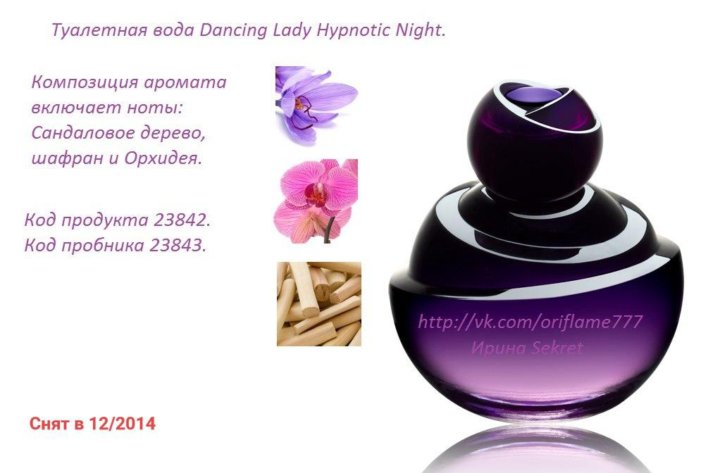 In winter, he feels quite comfortable at 18 degrees, but a more significant decrease (but not lower than 7 degrees) will not harm him.
In winter, he feels quite comfortable at 18 degrees, but a more significant decrease (but not lower than 7 degrees) will not harm him. - Watering. It is interesting here: during the growth of leaves and stems, as well as when a flower arrow appears, water should not be saved. It is better to water the flower by immersion in a basin with “drinking” (that is, settled) water. And when the pseudobulb is growing or when flowering ends, you need to water the flower very carefully.
- Spraying. Not required. They can be carried out only in extreme heat, or in winter, with the "terror" of radiators. If the temperature in the room is below 18 degrees, it's time to hide the spray gun.
- Ventilation. Unlike spraying, a flower needs clean air at any time of the year. But make sure that the orchid does not stand in a draft, and also that it does not freeze (which species is especially sensitive to low air temperatures, read below).
- Nutrition. Top dressing, as well as active watering, is carried out with the growth of the orchid or at the beginning of flowering (until the arrow grows and the flowers have not blossomed - as soon as they bloom, stop feeding).
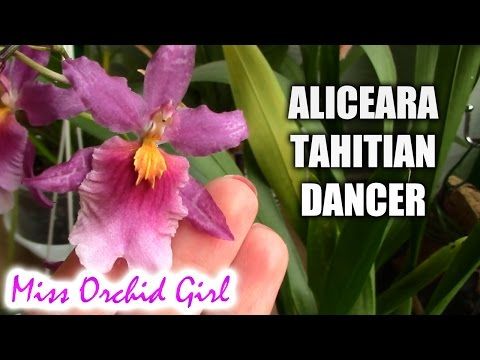 Make a solution of complex fertilizer for orchids weak. It is better to make it after watering with a watering can, but it can also be sprayed.
Make a solution of complex fertilizer for orchids weak. It is better to make it after watering with a watering can, but it can also be sprayed. - Special growing conditions. Oncidium requires winter dormancy. But not all varieties. Yes, hybrids that have bulbs can "winter" in their usual environment. If the plant does not have pseudobulbs, after the end of shoot growth, it needs to rest. Do not feed, rarely water the flower, and if possible, move the pot to a colder room.
Temperature preferences of oncidium orchids vary by species
- Cold-loving. These are Sinuous and Warty oncidiums. Their homeland is cool mountain forests, so plants prefer a maximum of 22 degrees in summer, and about 8 degrees in winter.
- "Medium". Tiger and Beautiful oncidium are good in winter at 13-15 degrees, and in summer at 20-25.
- Thermophilic. Oncidium Lanza and Butterfly will not bloom if the room is colder than 15 degrees in winter and below 25 in summer.
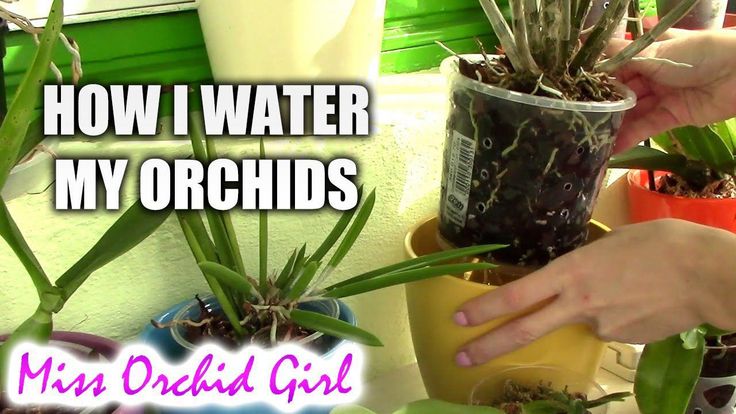
In most of our stores you will only find Dutch oncidium hybrids. They are considered the most unpretentious: they bloom both at 26 and at 14 degrees.
Transplanting this orchid
Like other orchids (say Cattleya), oncidium does not like to be disturbed by transplanting.
- On average, the plant is transplanted every 3 years.
- There may be several reasons: compacted and/or saline substrate, roots that do not fit in the pot, suspicion of rot inside the pot.
- The procedure is carried out in the spring.
- The pot can be taken wide, but not deep, from an opaque material.
- Clean pine bark can be used as the ground. However, it can be flavored with sand (coarse, river), chalk, charcoal.
- Always add drainage to the bottom of the pot.
- After planting a flower, the substrate can be spilled with a solution of "Fundazol" ("vaccination" against diseases, made from 1 liter of water and 2 g of this medicine).
